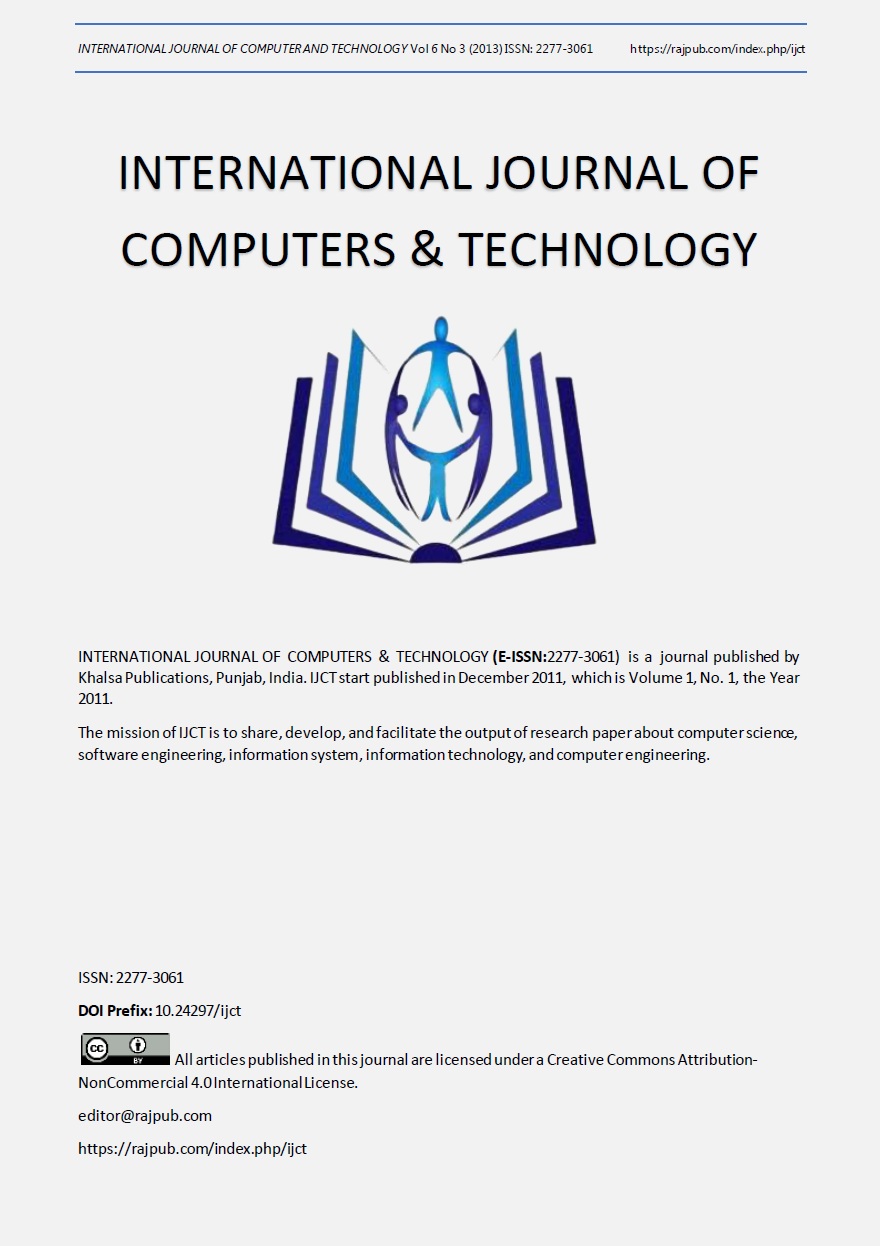Performance of BAT Algorithm on Localization of Wireless Sensor Network
DOI:
https://doi.org/10.24297/ijct.v6i3.4481Keywords:
Wireless sensor network, localization, Bat algorithmAbstract
Many applications of wireless sensor networks (WSN) require information about the geographical location of each sensor node. Devices that form WSN are expected to be remotely deployed in large numbers in a sensing field, and to self -organize to perform sensing and acting task. The goal of localization is to assign geographical coordinates to each device with unknown position in the deployment area. Recently, the popular strategy is to apply optimization algorithms to solve the localization problem. In this paper, the bat algorithm is implemented to estimate the sensor‟s position.
Downloads
References
Challenges,†Network Protocols and Algorithms ISSN 1943-3581 2010, Vol. 2, No. 1
[2] Anushiya A Kannan, Guoqiang Mao and Branka Vucetic, “ Simulated Annealing based Wireless Sensor Network
Localization†Journals of computer, vol 1, No. 2, May 2006.
[3] L. Doherty et al., “Convex position estimation in wireless sensor networks,†in INFOCOM 2001. Twentieth Annual
Joint Conference of the IEEE Computer and Communications Societies. Proceedings., vol.3, 2001, pp. 1655–1663.
[4] R. Kulkarni, G. Venayagamoorthy, and M. Cheng, “Bio-inspired node localization in wireless sensor networks,†in
IEEE International Conference on Systems, Man and Cybernetics, 2009. SMC 2009., pp. 205–210.
[5] A. Pal, “Localization algorithms in wireless sensor networks: Current approaches and future challenges,†Network
Protocols and Algorithms, vol. 2, no.1, pp.45–73, 2010.
[6] I. Akyildiz, W. Su, Y. Sankarasubramaniam, and E. Cayirci, “Wireless sensor networks : a survey,†Computer
networks, vol. 38, no. 4, pp. 393–422, 2002.
[7] J. Wang, R. K. Ghosh, and S. K. Das, “A survey on sensor localization,†Journal of Control Theory and Applications,
vol. 8, no. 1, pp. 2–11, 2010.
[8] A. Boukerche, H. Oliveira, E. Nakamura, and A. Loureiro, “Localization systems for wireless sensor networks,â€
wireless Communications, IEEE, vol. 14, no. 6, pp. 6–12, 2007.
[9] J. Hightower and G. Borriello, “Location systems for ubiquitous computing,†Computer, vol. 34, no. 8, pp.57–66, 2001.
[10] D. Niculescu and B. Nath, “Ad hoc positioning system (aps),†in Global Telecommunications Conference, 2001.
GLOBECOM 01. IEEE, vol. 5. IEEE, 2001, pp. 2926–2931.
[11] N. Bulusu, D. Estrin, L. Girod, and J. Heidemann, “Scalable coordination for wireless sensor networks: selfconfiguring
localization systems,†in International Symposiumon Communication Theory and Applications
(ISCTA2001), Ambleside, UK, 2001.
[12] A. Savvides, H. Park, and M. Srivastava, “ The bits and flops of the n-hop multilateration primitive for node localization
problems,†in Proceedings of the 1st ACM international workshop on Wireless sensor networks and applications.
ACM, 2002, pp. 112–121.
[13] M. Di Rocco and F. Pascucci, “Sensor network localization using distributed extended kalman filter,†in IEEE/ASME
international conference on Advanced intelligent mechatronics, 2007. IEEE, 2007, pp.1–6.
[14] R. Kalman, “A new approach to linear filtering and prediction problems,†Journal of basic Engineering, vol. 82, no.
Series D, pp. 35–45, 1960.
[15] Y. Shang and W. Ruml, “Improved MDS-based localization,†in Twenty third Annual Joint Conference of the IEEE
Computer and Communications Societies INFOCOM 2004, vol. 4. IEEE, 2004, pp. 2640–2651.
[16] P. Biswas, T. Lian, T. Wang, and Y.Ye, “Semi definite programming based algorithms for sensor network
localization,†ACM Transactions on Sensor Networks (TOSN), vol. 2, no. 2, pp. 188–220, 2006.
[17] S. Yun, J. Lee, W. Chung, E. Kim, and S. Kim, “A soft computing approach to localization in wireless sensor
networks,†Expert Systems with Applications, vol. 36, no. 4, pp.7552–7561,2009.
[18] Q. Zhang, J. Wang, C. Jin, and Q. Zeng, “Localization algorithm for wireless sensor network based on genetic
simulated annealing algorithm,†in 4th International Conference on Wireless Communications Networking and Mobile
Computing, 2008. WiCOM08. IEEE, 2008, pp.1–5.
[19] Q. Zhang, J. Huang, J. Wang, C. Jin, J. Ye, and W. Zhang, “A new centralized localization algorithm for wireless
sensor network,†in Third International Conference on Communications and Networking in China, physical world with
pervasive networks,†Pervasive Computing, IEEE, 2008. China Com 2008. IEEE, 2008, pp. 625–629.
[20] Y. Li, J. Xing, Q. Yang, and H. Shi, “Localization research based on improved simulated annealing algorithm in WSN,â€
in 5th International Communications of Conference on Wireless Communications, Networking and Mobile Computing,
2009. WiCom 09. IEEE, 2009, pp. 1–4.
[21] R. Kulkarni, G. Venayagamoorthy, and M. Cheng, “Bio-inspired node localization in wireless sensor networks,†in
IEEE International Conference on Systems, Man and Cybernetics, 2009. SMC 2009., pp.205–210.],
[22] A. Gopakumar and L. Jacob, “Localization in wireless sensor networks using particle swarm optimization,†in IET
International Conference on Wireless, Mobile and Multimedia Networks, 2008. IET, 2008, pp.227–230.
[23] R. Stoleru and J. A. Stankovic, “Probability grid: A location estimation scheme for wireless sensor networks,†in First
Annual IEEE Communications Society Conference on Sensor and Ad Hoc Communications networks, 2004. IEEE
SECON 2004. IEEE, 2004, pp.430–438.
[24] P. Chuang and C. Wu, “An effective pso-based node localization scheme for wireless sensor networks,†in Ninth
International Conference on Parallel and Distributed Computing, Applications and Technologies, 2008. PDCAT 2008.
IEEE, 2008, pp.187–194.
[25] G. Mao, B. Fidan, and B. Anderson, “Wireless sensor network localization techniques,†Computer Networks, vol. 51,
no.10, pp.2529–2553, 2007.
[26] Yang, X. S. (2010a). A new metaheuristic bat-inspired algorithm, in: Nature Inspired Cooperative Strategies for
Optimization (NICSO2010) (Eds. J. R. Gonzalez et al.), Springer, SCI Vol. 284, 65-74.
[27] Yang, X. S., (2011), Bat Algorithm for Multiobjective Optimization, Int. J. Bio-Inspired Computation, Vol. 3, No. 5, pp.
267-274.









